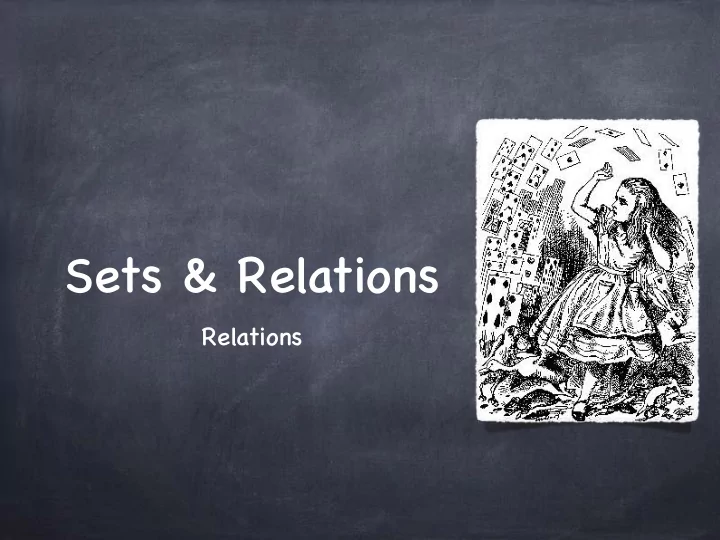

Sets & Relations Relations
Relations: Basics More commonly written as: x Likes y, x ⊏ y , x ≥ y, x~y, xLy, ... Informally, a relation is specified as what is related to what Formally, a predicate over the domain S × S x,y Likes(x,y) e.g. Likes(x,y) Alice, Alice TRUE Alternately, a subset of S × S, Alice, Jabberwock FALSE namely the pairs for which the Alice, Flamingo TRUE relation holds Jabberwock, Alice FALSE Jabberwock, Jabberwock TRUE Likes = { (Alice,Alice), Jabberwock, Flamingo FALSE (Alice, Flamingo), Flamingo, Alice FALSE Homogeneous (J’wock,J’wock), Flamingo, Jabberwock FALSE and binary Flamingo, Flamingo TRUE (Flamingo,Flamingo) } (the default notion for us)
Many ways to look at it! R ⊆ S × S Boolean matrix, (directed) graph a set of M a,b = T iff a ⊏ b ordered-pairs { (a,b) | a ⊏ b } A J F J A T F T { (A,A), (A,F), J F T F A F F F F T (J,J), (F ,F) }
Operations on Relations Since a relation is a set, namely R ⊆ S × S, all set operations extend to relations Complement (with the universe being S × S), Union, Intersection, Symmetric Difference Converse (a.k.a. Transpose) M Txy = M yx R T = { (x,y) | (y,x) ∈ R } w “Boolean matrix multiplication” Composition (M ○ M’) xy = ⋁ w (M xw ⋀ M’ wy ) y x R ○ R’ = { (x,y) | ∃ w ∈ S (x,w) ∈ R and (w,y) ∈ R’ }
Types of Relations (Ir)Reflexive Relations Reflexive (e.g. Knows, ≤ ) The kind of relationship that everyone has with themselves All self-loops All of diagonal included None of it Irreflexive (e.g. Gave birth to, ≠ ) The kind that nobody has with themselves No self-loops Neither (e.g. is a prime factor of) Some, but not all, have this relationship with themselves
Types of Relations (Anti)Symmetric Relations Symmetric (e.g. sits next to) The relationship is reciprocated symmetric matrix self-loops & Anti-symmetric (e.g. parent of, prime factor of, ⊆ ) bidirectional edges only No reciprocation (except possibly with self) no bidirectional edges Neither (e.g. likes) Reciprocated in some pairs (with distinct members) and only one-way in other pairs some bidirectional, some unidirectional Both (e.g., =) no edges except Each one related only to self (if at all) self-loops
Types of Relations Transitive Relations Transitive (e.g., Ancestor of, subset of, divides, ≤ ) if a is related to b and b is related to c, then a is related to c ↔ ∀ k>1 R k ⊆ R R is transitive ↔ R ○ R ⊆ R if there is a “path” from a to z, then there is edge (a,z) Intransitive: Not transitive
Types of Relations Symmetric: Anti-symmetric: Transitive: Reflexive: Irreflexive: Only self-loops & No bidirectional Path from a to b All self-loops No self-loops bidirectional edges edges implies edge (a,b) The complete relation R = S × S is reflexive, symmetric and transitive Reflexive closure of R: Minimal relation R’ ⊇ R s.t. R’ is reflexive Symmetric closure of R: Minimal relation R’ ⊇ R s.t. R’ is symmetric Transitive closure of R: Minimal relation R’ ⊇ R s.t. R’ is transitive Each of these is unique [Why?]
Equivalence Relation A relation that is reflexive, symmetric and transitive e.g. is a relative, has the same last digit, is congruent mod 7, … Equivalence class of x: Eq(x) ≜ {y|x ∼ y} . Every element is in its own equivalence class (by reflexivity) Claim: If Eq(x) ∩ Eq(y) ≠ Ø, then Eq(x) = Eq(y). Let z ∈ Eq(x) ∩ Eq(y). To show Eq(x) ⊆ Eq(y) [similarly, Eq(y) ⊆ Eq(x)] Consider an arbitrary w ∈ Eq(x): i.e., x ∼ w. By symmetry, z ∼ x. Then, by transitivity, z ∼ w. Then, y ∼ w. z Thus, w ∈ Eq(y). i.e., Eq(x) ⊆ Eq(y). y x ✓ w
Equivalence Relation A relation that is reflexive, symmetric and transitive e.g. is a relative, has the same last digit, is congruent mod 7, … Equivalence class of x: Eq(x) ≜ {y|x ∼ y} . Every element is in its own equivalence class (by reflexivity) Claim: If Eq(x) ∩ Eq(y) ≠ Ø, then Eq(x) = Eq(y). The equivalence classes partition the domain P 1 ,..,P t ⊆ S Square blocks along the “Cliques” for s.t. diagonal, after sorting each class P 1 ∪ .. ∪ P t = S the elements by P i ∩ P j = Ø equivalence class
Symmetric: Anti-symmetric: Transitive: Reflexive: Irreflexive: Only self-loops & No bidirectional Path from a to b All self-loops No self-loops bidirectional edges edges implies edge (a,b) Equivalence: Cliques, disconnected from each other Reflexive closure of R: Smallest relation R’ ⊇ R s.t. R’ is reflexive Symmetric closure of R: Smallest relation R’ ⊇ R s.t. R’ is symmetric Transitive closure of R: Smallest relation R’ ⊇ R s.t. R’ is transitive An equivalence relation R is its own reflexive, symmetric and transitive closure
Recommend
More recommend